ABSTRACT
Anthropogenic activities, including replacing natural forests with human settlements and increased agricultural activities have environmental impacts. The activities can contaminate aquatic ecosystems including spring waters that are sources of major rivers like the Amala and Nyangores, tributaries of Mara River in Mau Complex. In the complex, forestlands have been converted to human settlements and agricultural lands. Although residents of the Mara River Basin use the spring waters for domestic and animal watering purposes, evaluation of the impact the activities have on the spring water quality has not been done. This study evaluated the site and seasonal variations of zinc, copper, selenium, manganese, chromium, cadmium and lead concentrations in spring waters within the Mau Complex where forests have been cleared and converted to anthropogenic activities. The study covered areas along Amala and Nyangores rivers. There were variations (p≤0.05) in the heavy metals levels with sites and seasons. Except for Mn, Cu and Cd which were lower, the levels of the other heavy metals in water from the control points (undisturbed forest areas) were higher in downstream areas that had undergone massive anthropogenic activities. Although there were seasonal variations (p≤0.05), the pattern was not clear. Some heavy metals levels were higher in wet seasons while others were higher in dry season. But the heavy metals levels were within the recommended international standards for domestic/animal use. These results demonstrate that the anthropogenic activities were not yet causing pollution of the spring waters. Maintaining the anthropogenic activities at present levels is recommended. However, periodic monitoring to ascertain the quality of the spring water is necessary to mitigate increase to detrimental levels with time. These results contribute knowledge helping regulatory agencies and management of Lake Victoria basin to formulate monitoring polices to curb water quality deterioration.
Key words: Anthropogenic activities, heavy metals, spring water, River Mara, Mau Complex.
Mara River basin, especially on the high highlands, where the main tributaries (Rivers Amala and Nyangores) traverse used to be part of the Mau Forest (McCartney, 2010). The area has undergone massive deforestation (Defersha and Melesse, 2012, Mango et al., 2010, 2011). Between 1973 and 2008, the Mau Forest and range land conversion to agriculture was over 203% (Mati et al., 2008). Such conversion to anthropogenic activities cause environmental, soil and water quality degradation problems that affect human, animal and aquatic life (UNEP, 2006). Studies within the Mara River basin have demonstrated that deforestation and human settlement have increased soil erosion and sedimentation and caused extreme water flow events (Dessu and Melesse, 2012, 2013, Mango et al., 2011). The changes these anthropogenic activities can cause in the spring water quality, especially the levels of heavy metals in ground water have not been quantified.
Springs are susceptible to contamination since water feeding them flows through the ground for only a short distance, thus limiting possible natural filtering. Consequently, springs may not be good choice for a water supply if the area uphill has industrial, agricultural, or other activities that can be sources of pollution (Varol and Åžen, 2012). In many parts of the world, decline in water quality has been associated with anthropogenic activities uphill of the waters sources. Examples of such incidences include decline in water quality in China (Huang et al., 2015; Yang et al., 2015); Turkey (Varol, 2011; Varol and Åžen, 2012), Taiwan (Chen et al., 2015), India (Jain, 2004), Sweden (Loefgren et al., 2014), and Nigeria (Akintoye et al., 2014). The anthropogenic activities in water catchment areas destroy the forest cover necessary in preventing soil erosion and sediment deposition into the water bodies (Foley et al., 2005; Liu et al., 2007). The activities also cause deterioration of underground water quality (Almeida et al., 2007; Duruibe et al., 2007; Micó et al., 2006). Such quality deterioration can be high when the anthropogenic activities are close to springs. In the Mara River basin, forest lands have been converted into human use activities (McCartney, 2010; UNEP, 2006). The basin has witnessed increase in human settlement (McCartney, 2010), agriculture (Matano et al., 2015; McCartney, 2010), urban centers development (McCartney, 2010; UNEP, 2006) and tourist activities, which are possible sources of contamination (McCartney, 2010; Nyairo et al., 2015; UNEP, 2006).
The Mara River drains into Lake Victoria, which thereafter flows into the River Nile and the Mediterranean Sea. The water is a source of livelihood for many people in Kenya, Tanzania, Southern Sudan, Sudan and Egypt. Consequently, its water contamination/quality deterioration can affect lives of many people together with animals and aquatic life. Changes in the water quality of the Mara River water basin have been documented (McCartney, 2010; Nyairo et al., 2015; Wafula et al., 2017). The Mara River sources are mainly the rivers Amala and Nyangores, which are fed by springs in the Mau Forest and former Mau Forest areas within the River Mara basin. There has been no documentation of the contribution of the springs forming sources of Amala and Nyangores Rivers to the Mara River water quality. The objective of this study was to assess the levels on heavy metals in the spring waters feeding the Amala and Nyangores rivers.
Seasonal variations in anthropogenic activities usually influence quality of river water downstream (Ma et al., 2005; Chang, 2008; Li et al., 2009; Simeonov et al., 2003). The water quality changes can be variable where there are seasonal variations in agricultural (Micó et al., 2006), industrial (Ma et al., 2005, Simeonov et al., 2003) and tourist (Almeida et al., 2007) activities. Within the Mara River basin, these economic activities vary with seasons. Usually, tourist activities are high when it is winter season in the northern hemisphere. Agricultural activities within the basin are mainly rain fed and most agricultural activities are undertaken during the long rains in April-June and short rains in October-November (Jaetzold et al., 2007). The main industry within the Mau Complex, is tea production that runs throughout the year. Although, the influence of these activities on the water quality on Rivers Amala and Nyangores were recently demonstrated (Nyairo et al., 2015), their influence on spring water quality have not been established. This study also evaluated the variations in heavy metals (Mn, Cu, Zn, Pb, Cr, and Cd) and Se in springs at the catchment of Rivers Amala and Nyangores with site and seasons.
Study area
The springs were randomly selected in the catchment of Nyangores and Amala rivers located in the Mau Forest Complex within Narok and Bomet counties, Kenya (Figure 1). Mara River basin is a trans-boundary basin shared by Kenya and Tanzania and is part o the larger Nile River Basin. The basin lies between latitudes 0°38' and 1° 03' south and between longitudes 35° 01' and 35° 33' east (Figures 1 and 2). The area was heavily forested (UNEP, 2006, 2009) with typical equatorial natural forest trees, but parts have been converted to large and small scale farming and a buffer zone of tea plantation introduced by the government to stop encroachment into the forest. It is an important water tower for the Kenya (GOK, 2008a, b). The small scale farming crops in the area are dominated by maize, beans, peas, potatoes, tea, wheat and vegetables.
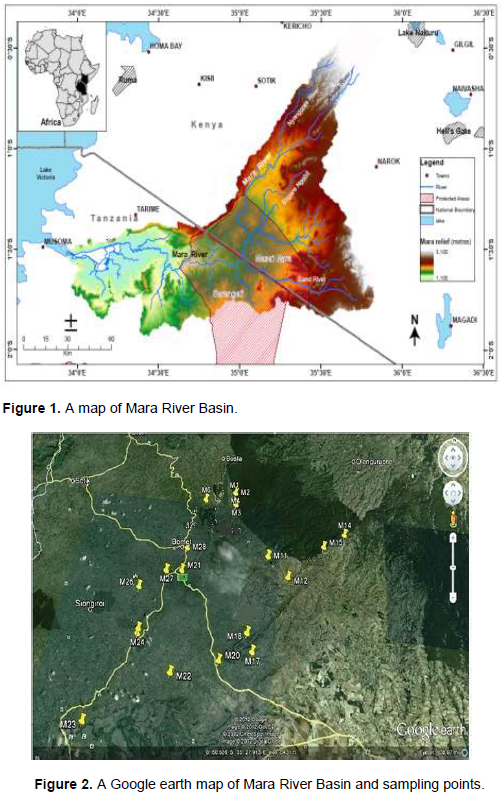
A total of sixteen (Table 1) springs were randomly selected, of which two (Tenganda (M2) and Kebenet (M14)) were located in the forest, were used as controls. Springs (Kapsosrurwa (M6), Silbwet (M11), Sotionik 1 (M12), Sotionik 2 (M20), Ainabsabet (M15), Kapsoen 1 (M17), Kapsoen 2 (M18), Chepudonge (M21), Motiok (M22), Chepkesoi (M23), Kapangas 1 (M24), Kapangas 2 (M26), Ndong Ndong (M27) and Siongiroi (M28)) were located in sections of the river where small scale farming of tea, maize and potatoes interspersed with agro-forestry and animal husbandry.
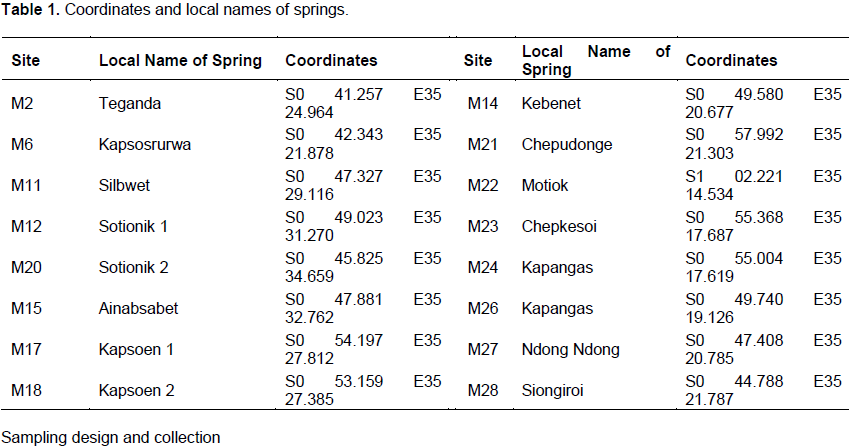
Water sampling was done in two seasons, dry and wet season, using a pre-cleaned water sampler. The water samples were collected just below the water surface and stored in pre-cleaned amber colored 2.5 L glass bottles. The bottles had been pre-cleaned by soaking in 10% nitric acid overnight and rinsed with distilled water on the day of sampling. Each sample was treated with 10 ml of 6N HNO3 solution for preservation. The samples were then transported to the laboratory and filtered immediately using Whatman filter paper then stored at -20°C pending extraction (AOAC, 2000; APHA, 1995).
Determination of parameters
The water samples were filtered through a 1 µm cellulose acetate millipore filter, acidified by 1% (2 ml) concentrated nitric acid, and then pre-concentrated by evaporating 200 to 30 ml on a hot plate at 60°C (Mzimela et al., 2003). The evaporated samples were transferred to a 50 ml volumetric flask and made-up to the volume with double distilled water after addition of 1.5 mg/ml of strontium chloride.
The extracts were analyzed for Pb, Cu, Zn, Mn, Se, Cd and Cr using an atomic absorption spectrophotometer, Shimadzu Atomic Absorption Flame Spectrophotometer, Model AA-6200 (Kyoto, Japan).
Statistical analysis
The data were subjected to statistical analysis of variance (ANOVA) using a two factor completely randomized design. SAS statistical package and GraphPad Prism for students’t-test (p≤0.05) was used to check the variations.
All the heavy metals (Tables 2 and 3) significantly (p≤0.05) varied with site for both springs flowing into Amala and Nyangores. Mn, Cu and Cd were lower (p≤0.05) in water from springs that water still under natural forest (Kebenet and Teganda) than springs in areas that had been subjected to anthropogenic activities. For some heavy metals, the levels in spring waters were similar to or higher than those of the control sites, which were in virgin forest areas. The spring water heavy metals ranged from 0.009 to 0.602 ppb for Pb in Chepudonge and Kebenet, 0.014 to 0.054 ppb Mn in Chepudonge and Ndong Ndong, 0.073 to 0.609 ppb Cu in Kapangas 2 and Kapangas 1, 0.004 to 0.602 ppb Zn in Kapangas 2 and Ndong Ndong, 0.035 to 0.465 ppb Se in Ndong Ndong and Chepkesoi, 0.448 to 0.946 ppb Fe in Kebenet and Motiok, 0.015 to 0.055 ppb Cr in Kebenet and Siongiroi and 0.093 to 0.819 ppb Cd in Motiok and Siongiroi, respectively, in springs flowing into Amala. For the spring flowing into Nyangores, the range of heavy metals ranges were 0.003 to 0.020 ppb Pb in Ainabsabet and Silbwet, 0.017 to 0.058 ppb Mn in Sotionik 2 and Silbwet, 0.137 to 0.257 ppb Cu in Kapsoen 1 and Teganda, 0.002 to 0.173 ppb Zn in Kapsosrurwa and Sotionik 2, 0.095 to 0.386 ppb Se in Kapsosrurwa and Ainabsabet, 0.439 to 0.577 ppb Fe in Ainabsabet and Sotionik 2, 0.064 to 0.410 ppb Cr in Kapsosrurwa and Teganda, and 0.013 to 0.042 ppb Cd in Teganda and Kapsoen 2, respectively. Apart from fluoride levels that had been reported to be high in some spring waters in Kenya (Gaciri and Davies, 1993), heavy metals levels in spring water in Kenya had not been reported. However, comparable in levels of some heavy metals of springs from the similar catchments had been observed in other countries such as India (Prasad and Bose, 2001), Mexico (Wyatt et al., 1998), and Jordan (Batayneh, 2010). But in Turkey, heavy metals levels were higher than acceptable limits in sediments from springs in Karasu creek demonstrating contamination (Yalcin et al., 2007). In this study, all the heavy metals exhibited low concentrations in the spring waters across the sites. Indeed, these levels were lower than the water quality limits for domestic/animal use purposes (USEPA, 2014; WHO, 2014). These results suggest that the effect of the anthropogenic activities were not yet causing significant spring water heavy metals pollution in the upper Mau River complex.
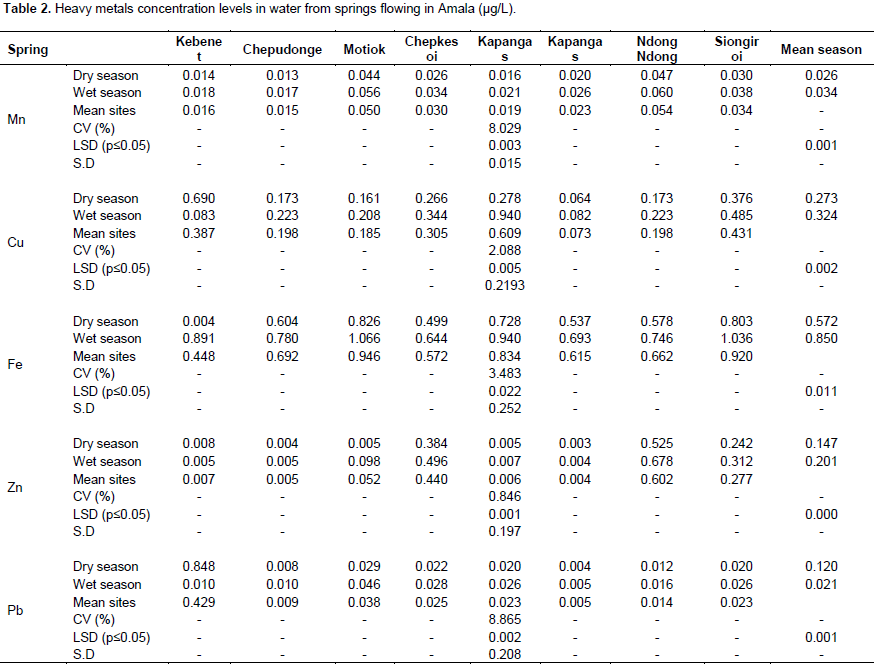

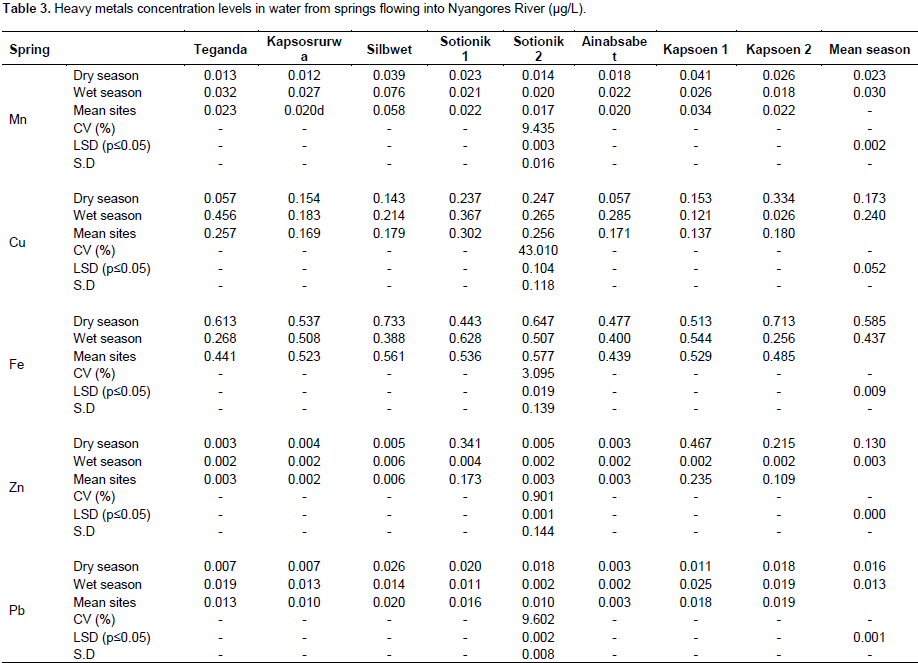
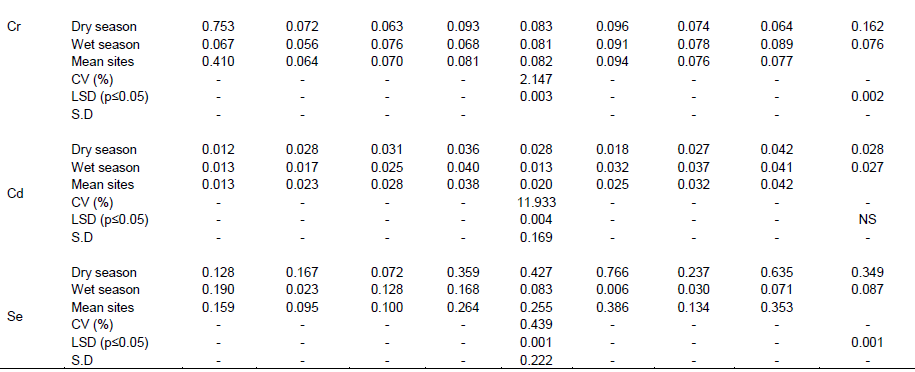
All the heavy metals (Tables 2 and 3) varied significantly (p≤0.05) with seasons, with the exception of Cd on the Nyangores River sode. For the springs flowing into Amala River Mn, Cu, Fe, Zn, Cr, and Cd concentrations were higher in wet seasons while Pb and Se were levels were higher in the dry season. Only levels of Mn and Cu were higher while Fe, Zn, Pb, and Cr were lower in wet season than dry season in water flowing into the Nyangores River. Variations in the distribution of heavy metals appeared to be controlled by hydro-biological/geological conditions (Sankar et al., 2010) than the anthropogenic activities. Seasonal variations in heavy metals concentrations in the spring waters may have arisen from the rapid growth of population and increased agricultural activities (Abdel-Baki et al., 2011). The level of heavy metals recorded in water in this study are generally low when compared with the environmental limits suggested by WHO (WHO, 2014) (Table 5), and USEPA (USEPA, 2014). These results demonstrate that the anthropogenic activities in the upper Mau River Complex in the catchment of rivers Amala and Nyangores are not yet causing serious spring water quality deterioration.
Comparison of the mean data from Amala and Nyangores (Table 4) reveals that levels Mn, Cu, Zn, Pb, Cr and Se were not different (p≤0.05), while Fe and Cd were higher in spring waters draining into the Amala River than Nyangores River. The lack of differences in most heavy metals levels were attributed to the fact that these areas were deforested within the same time range and have been subjected to similar anthropogenic activities. Differences in Fe and Cd could have arisen from variations in hydro-biological/geological differences (Tables 6 to 8).
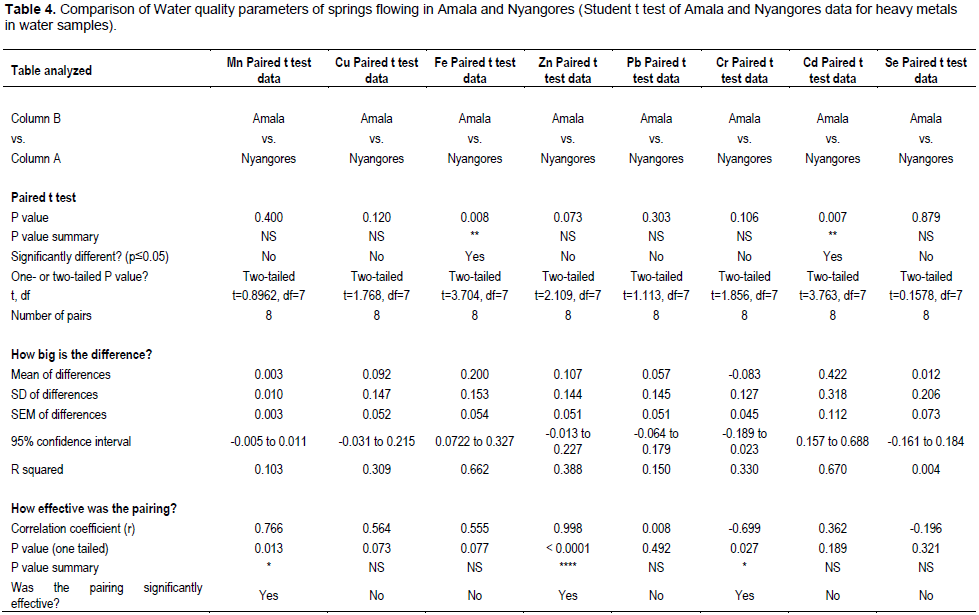
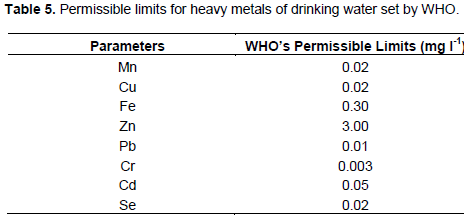

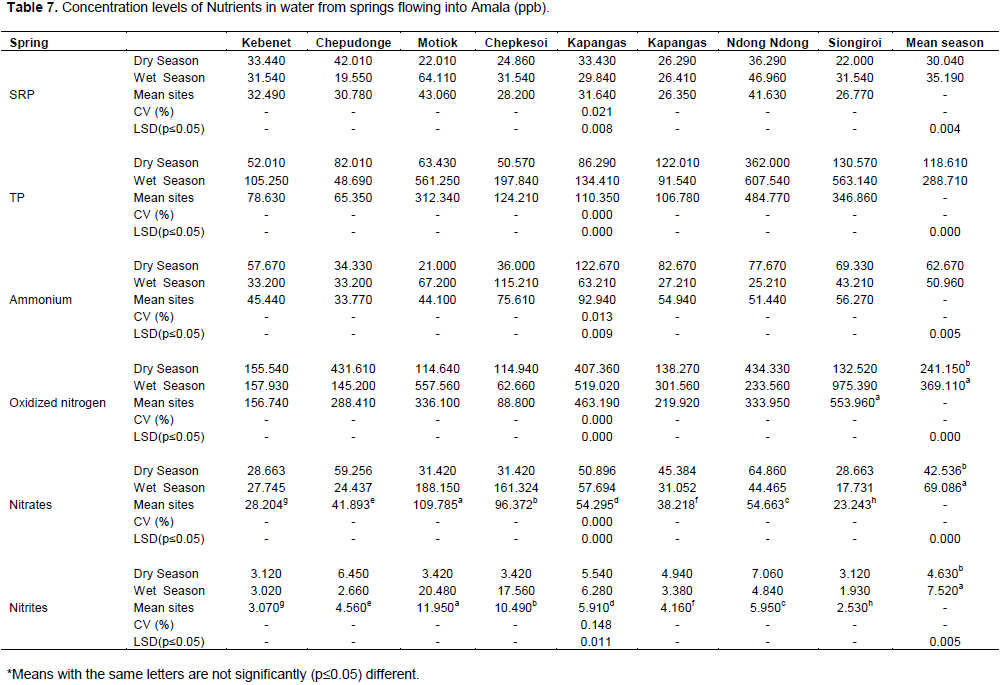

In conclusion, the anthropogenic activities at the catchment of Amala and Nyangores, tributaries of Mara River have not caused serious increase in the heavy metals levels in spring waters within the catchment area. Thus, the spring water in and around Mau Forest water towers are suitable for domestic/animal use. The contribution of the springs to the heavy metal load to the River Mara from water from springs flowing into the tributaries of the Amala and Nyangores are minimal and insignificant. The anthropogenic activities within the area should be maintained at the current levels, but there is need for continuous surveillance since long term activities could alter the status. Periodic monitoring of the spring waters for heavy metal is recommended.
The authors have not declared any conflict of interests.
This research was supported by the Lake Victoria Basin Commission (LVBC) and the Department of Chemistry of Maseno University.
REFERENCES
|
Abdel-Baki AS, Dkhil MA, Al-Quraishy S (2011). Bioaccumulation of some heavy metals in tilapia fish relevant to their concentration in water and sediment of Wadi Hanifah, Saudi Arabia. Afr. J. Biotechnol. 10:2541-2547.
|
|
|
|
Akintoye AO, Obi CN, Etim OA, Olorundami T, Ukata SU, Harrison U (2014). Seasonal variation in the physicochemical characteristics of surface water in Etche River, Niger Delta Area of Nigeria. J. Environ. Sci. Toxicol. Food Technol. 8(7):1-7.
|
|
|
|
|
Almeida CA, Quintar S, González P, Mallea MA (2007). Influence of urbanization and tourist activities on the water quality of the Potrero de los Funes River (San Luis–Argentina). Environ. Monit. Assess.133:459-465.
Crossref
|
|
|
|
|
AOAC (2000). Official Methods of Analysis. 17th ed. Maryland, USA, Association of Analytical Chemists International.
|
|
|
|
|
APHA (1995). Standard method for examination of water and wastewater.) Washington, DC, American Public Health Association.
|
|
|
|
|
Batayneh AT (2010). Heavy metals in water springs of the Yarmouk Basin, North Jordan and their potentiality in health risk assessment. Int. J. Phys. Sci. 5:997-1003.
|
|
|
|
|
Chang H (2008). Spatial analysis of water quality trends in the Han River basin, South Korea. Water Res. 42:3285-3304.
Crossref
|
|
|
|
|
Chen TH, Chen YL, Chen CY, Liu PJ, Cheng JO, KO FC (2015). Assessment of ichthyotoxicity and anthropogenic contamination in the surface waters of Kenting National Park, Taiwan. Environ. Monit. Assess. 187:1-16.
Crossref
|
|
|
|
|
Defersha MB, Melesse AM (2012). Field-scale investigation of the effect of land use on sediment yield and runoff using runoff plot data and models in the Mara River basin, Kenya. Catena, 89:54-64.
Crossref
|
|
|
|
|
Dessu SB, Melesse AM (2012). Modelling the rainfall–runoff process of the Mara River basin using the Soil and Water Assessment Tool. Hydrol. Process. 26:4038-4049.
Crossref
|
|
|
|
|
Dessu SB, Melesse AM (2013). Impact and uncertainties of climate change on the hydrology of the Mara River basin, Kenya/Tanzania. Hydrol. Process. 27:2973-2986.
|
|
|
|
|
Duruibe JO, Ogwuegbu MOC, Egwurugwu JN (2007). Heavy metal pollution and human biotoxic effects. Int. J. Phys. Sci. 2:112-118.
|
|
|
|
|
Foley JA, DeFries R, Asner GP, Barford C, Bonan G, Carpenter SR, Chapin FS, Coe MT, Daily GC, Gibbs HK (2005). Global consequences of land use. Science, 309:570-574.
Crossref
|
|
|
|
|
Gaciri SJ, Davies TC (1993). The occurrence and geochemistry of fluoride in some natural waters of Kenya. J. Hydrol. 143:395-412.
Crossref
|
|
|
|
|
GOK (2008a). Goverment of Kenya, Office of the Prime Minister, Ministry Of State For Planning, National Development and Vision 2030, Narok South District Development Plan. 2008 – 2012) Nairobi, Kenya, Government Press.
|
|
|
|
|
GOK (2008b). Government of Kenya, Office of the Prime Minister, Ministry Of State For Planning, National Development and Vision 2030, Bomet District Development Plan. 2008 – 2012) Nairobi, Kenya, Government Press.
|
|
|
|
|
Huang J, Amuzu-Sefordzi B, Li M (2015). Heavy metals and polychlorinated biphenyls (PCBs) sedimentation in the Lianhua Mountain Reservoir, Pearl River Delta, China. Environ. Monit. Assess.187:1-12.
Crossref
|
|
|
|
|
Jaetzold R, Schmidt H, Hornetz B, Shisanya C (2007). Farm management handbook of Kenya Vol. II- Natural conditions and farm management information 2nd edition. Part A West Kenya, Nairobi, Ministry of Agriculture.
|
|
|
|
|
Jain CK (2004). Metal fractionation study on bed sediments of River Yamuna, India. Water Res. 38:569-578.
Crossref
|
|
|
|
|
Li S, Gu S, Tan X, Zhang Q (2009). Water quality in the upper Han River basin, China: the impacts of land use/land cover in riparian buffer zone. J. Hazard. Mater. 165:317-324.
Crossref
|
|
|
|
|
Liu J, Dietz T, Carpenter SR, Alberti M, Folke C, Moran E, Pell AN, Deadman P, Kratz T, Lubchenco J, Ostrom E (2007). Complexity of coupled human and natural systems. Science, 317:1513-1516.
Crossref
|
|
|
|
|
Loefgren S, Froeberg M, Yu J, Nisell J, Ranneby B (2014). Water chemistry in 179 randomly selected Swedish headwater streams related to forest production, clear-felling and climate. Environ. Monit. Assess. 186:8907-8928.
Crossref
|
|
|
|
|
Ma JZ, Wang XS, Edmunds WM (2005). The characteristics of ground-water resources and their changes under the impacts of human activity in the arid Northwest China-a case study of the Shiyang River Basin. J. Arid Environ. 61:277-295.
Crossref
|
|
|
|
|
Mango LM, Melesse AM, McClain E, Gann D, Setegan GS (2010). A modeling approach to determine the impact of land use and climate change scenarios on the water flux of the upper Mara River. Hydrol. Earth Syst. Sci. 7:5851-5893.
Crossref
|
|
|
|
|
Mango LM, Melesse AM, McClain ME, Gann D, Setegn SG (2011). Hydro-meteorology and water budget of the Mara River Basin under land use change scenarios. Nile River Basin pp. 39-68
Crossref
|
|
|
|
|
Matano AS, Kanangire CK, Anyona DN, Abuom PO, Gelder FB, Dida GO, Owuor PO, Ofulla AV (2015). Effects of land use change on land degradation reflected by soil properties along Mara River, Kenya and Tanzania. Open J. Soil Sci. 5:20-38.
Crossref
|
|
|
|
|
Mati BM, Mutie S, Gadain H, Home P, Mtalo F (2008). Impacts of landâ€use/cover changes on the hydrology of the transboundary Mara River, Kenya/Tanzania. Lakes Reservoirs: Research and Management 13:169-177.
Crossref
|
|
|
|
|
McCartney BA (2010). Evaluation of Water Quality and Aquatic Ecosystem Health in The Mara River Basin, East Africa.), Florida International University.
|
|
|
|
|
Micó C, Recatalá L, Peris M, Sánchez J (2006). Assessing heavy metal sources in agricultural soils of an European Mediterranean area by multivariate analysis. Chemosphere, 65:863-872.
Crossref
|
|
|
|
|
Mzimela HM, Wepener V, Cyrus DP (2003). Seasonal variations of selected metals in sediments, water and tissue of the groovy Mullet, Liza dumerelli from Mhlathuze estuary South Africa. Mar. Pollut. Bull. 46:659-676.
Crossref
|
|
|
|
|
Nyairo WN, Owuor PO, Kengara FO (2015). Effect of anthropogenic activities on the water quality of Amala and Nyangores tributaries of River Mara in Kenya. Environ. Monit. Assess. 187:1-12.
Crossref
|
|
|
|
|
Prasad B, Bose J (2001). Evaluation of the heavy metal pollution index for surface and spring water near a limestone mining area of the lower Himalayas. Environ. Geol. 41:183-188.
Crossref
|
|
|
|
|
Sankar R, Ramkumar L, Rajkumar M, Sun J, Ananthan G (2010). Seasonal variations in physico-chemical parameters and heavy metals in water and sediments of uppanar estuary, Nagapattinam. Indian J. Environ. Biol. 31:681-686.
|
|
|
|
|
Simeonov V, Stratis JA, Samara C, Zachariadis G, Voutsa D, Anthemidis A, Sofoniou M, Kouimtzis T (2003). Assessment of the surface water quality in Northern Greece. Water Res. 37:4119-4124.
Crossref
|
|
|
|
|
UNEP (2006). Mau Complex under siege. Division of Early Warning and Assessment.) Nairobi Kenya, http://www.unep.org/dewa/assessments/EcoSystems/land/mountain/MauCrisis/index.asp, United Natons Environmental Programme.
|
|
|
|
|
UNEP (2009). Kenya: Atlas of Our Changing Environment.) Nairobi, United Nations Environmental Programme.
|
|
|
|
|
USEPA (2014). Water Resource Characterization.) Washington DC, Lockwood Green Engineering.
|
|
|
|
|
Varol M (2011). Assessment of heavy metal contamination in sediments of the Tigris river (Turkey) using pollution indices and multivariate statistical techniques. J. Hazard. Mater. 195:355-364.
Crossref
|
|
|
|
|
Varol M, Åžen B (2012). Assessment of nutrient and heavy metal contamination in surface water and sediments of the upper Tigris River, Turkey. Catena, 92:1-10.
Crossref
|
|
|
|
|
Wafula MSM, Owuor PO, Kengara FO, Ofula AVO, Matano AS (2017). Influence of land use practices on heavy metal loading in water and sediments along the Mara River of East Africa. Afr. J. Environ. Sci. Technol. In press.
|
|
|
|
|
WHO (2014). Guideline for Drinking Water Quality, Geneva, World Health Organization.
|
|
|
|
|
Wyatt CJ, Fimbres C, Romo L, Mendez RO, Grijalva M (1998). Incidence of heavy metal contamination in water supplies in Northern Mexico. Environ. Res. 76:114-119.
Crossref
|
|
|
|
|
Yalcin MG, Narin I, Soylak M (2007). Heavy metal contents of the Karasu creek sediments, Nigde, Turkey. Environ. Monit. Assess.128:351-357.
Crossref
|
|
|
|
|
Yang L, Wang L, Wang Y, Zhang W (2015). Geochemical speciation and pollution assessment of heavy metals in surface sediments from Nansi Lake, China. Environ. Monit. Assess.187:1-9.
Crossref
|
|
